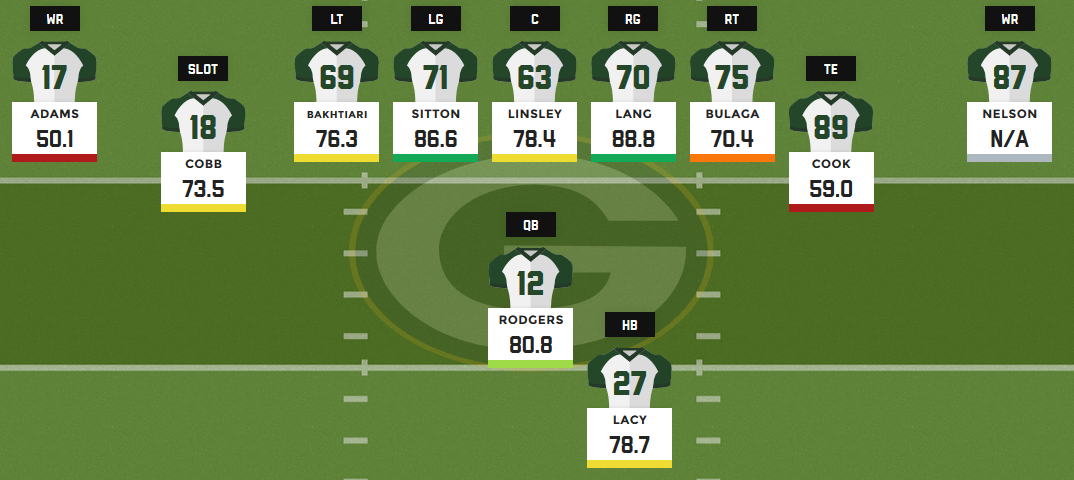(Editor’s note: As we lead up to the season, Director of PFF Fantasy Jeff Ratcliffe is breaking down each team’s depth chart from a fantasy perspective. Catch up on the work so far here.)
In a “down year” in 2015, the Packers still managed to win 10 games in the regular season and were extremely close to advancing to the NFC Championship game. That being said, Mike McCarthy’s team ranked just 23rd in total yards per game, which was a big dropoff from the 2014 team that ranked sixth.
There’s no questioning Aaron Rodgers’ ability, but his 2015 production was marred by poor receiver play, a middling run game and the preseason loss of Jordy Nelson to a torn ACL. The result was an abysmal season where he completed just 60.7 percent of his passes and managed just 6.7 yards per attempt, which was lowest among full-time starters. He was also sacked 46 times (second-most in the league), and only completed 43.3 percent of his throws when under pressure. But this wasn't the product of poor offensive line play. His lackluster receivers' inability to get open caused Rodgers to lead the league in dropbacks with more than 2.5 seconds in the pocket. With a better surrounding cast, Rodgers is poised to bounce back and is a real threat to be this year’s top fantasy quarterback.
Nelson’s impact on this offense can’t be understated. He tore his ACL in the preseason and the Packers just didn’t look the same without him on the field. When we last saw Nelson in 2014 he was the No. 2 fantasy receiver, and he ranked second in the league in deep-ball yardage with 577 yards on balls traveling more than 20 yards in the air. While he’s on the wrong side of 30 – Nelson turned 31 back in May – he’s by no means old for the position. With reports of Nelson’s recovery positive, expect him to be on the field when camp opens up. He slots right back in as a WR1.
Green Bay Packers projected 2016 offense with 2015 grades:
With Nelson out, the expectation of the fantasy drafting public was that Randall Cobb would slide into the No. 1 receiver role, and his ADP skyrocketed to No. 7 among wide receivers by the time fantasy drafts wrapped up last year. Cobb proved to be a big letdown, finishing 30th in fantasy scoring. But he showed in 2014 that he’s capable of strong production, ranking eighth among receivers in targets and sixth in fantasy points. Cobb has strong potential to bounce back with Nelson returning to the field.
The Packers’ third receiver job is going to be one of the league’s most interesting position battles to watch when training camp opens. Davante Adams was thrust into a prominent role last year, but he responded poorly, with 10 drops on 88 targets and one of the lowest fantasy points per opportunity numbers in the league. Some view Adams as the frontrunner for No. 3 duties, while others have him on the roster bubble. Jeff Janis is the other favorite for the job, following his breakout performance against the Cardinals in last year’s Divisional Round playoff game. Janis has impressive size and speed, but he’s still raw as a player. Ty Montgomery, Jared Abbrederis and Trevor Davis are also in the mix for the No 3 job. Whichever player emerges here will have fantasy relevance in the Green Bay offense that makes heavy usage of three-wide sets.
At tight end, the Packers signed veteran Jared Cook to go along with incumbent Richard Rodgers. Cook figures to be the primary receiving tight end, and the Packers plan to use him as a field stretcher. That’s something Green Bay hasn’t had at tight end since Jermichael Finley. While Cook has loads of athleticism, he’s been a general disappointment for fantasy purposes over his career. He certainly has upside with one of the NFL’s all-time greats throwing him the ball, but Cook shouldn’t be considered anything more than a risky TE2 with upside.
One of the common narratives among fantasy players is that Eddie Lacy was “terrible” in 2015. Lacy was one of the top running backs drafted last year, and he managed to finish a lowly 25th in fantasy scoring. Despite this disappointing fantasy finish, it’s tough to argue that he was truly bad. Lacy averaged 4.1 yards per carry – that’s a half-yard more than Jeremy Langford – and he graded out as our No. 15 halfback. That’s really far from terrible. However, his physical condition certainly wasn’t ideal, and Lacy has taken steps to remedy that problem in the offseason. If he enters this season in good shape, Lacy is a strong candidate to bounce back from last year’s sluggish fantasy production.
[How high will Nelson go in his return season? And how far will Cobb fall after a rough 2015? Check out our PFF Draft Master tool and try a mock draft, complete with offensive line grades, full projections and all the PFF data.]
James Starks and John Crockett round out the depth chart at running back behind Lacy. Starks struggled down the stretch last season, averaging just 3.8 yards per carry from Week 8 on. But he did show well as a receiver with 49 catches on 56 targets for the season. Entering his age-30 season, Starks is a complementary player who will only have viable fantasy value if Lacy falters or gets hurt.
Moving to the defensive side of the ball, the Packers’ 3-4 defense limits the IDP value of both Clay Matthews and Julius Peppers. Both are classified as outside linebackers, which means limited fantasy value outside of big-play scoring formats. Inside linebacker has been a weak spot for this team in recent seasons. Sam Barrington currently projects as one starter, with the other job likely coming down to Jake Ryan or Blake Martinez. Of the three, Barrington is the most likely IDP asset. He’s landed on injured reserve twice in the last three season, but Barrington has LB3 potential if he stays healthy. At safety, the Packers boast arguably the league’s best fantasy tandem in Ha Ha Clinton-Dix and Morgan Burnett. Clinton-Dix finished sixth among defensive backs in fantasy scoring last season, and he’s again an elite option. Burnett missed time in 2015, but ranked 11th in fantasy scoring at the position from Week 8 on. He’s still capable of posting DB1 numbers.



 © 2025 PFF - all rights reserved.
© 2025 PFF - all rights reserved.